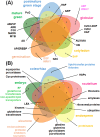Diversity of organ-specific plant transcriptomes
- PMID: 40740964
- PMCID: PMC12307246
- DOI: 10.3389/abp.2025.14609
Diversity of organ-specific plant transcriptomes
Abstract
Plant transcriptomes comprise nuclear and organellar (mitochondrial and plastid) transcripts expressed by nuclear and organellar genomes, respectively. They are spatiotemporally shaped during development. The aim of this review was to summarize the most relevant transcriptomic responses in various plant organs and tissues in the developmental context. The dynamicity of organ- or tissue-specific transcriptomic responses was discussed based on the complexity and diversity of the recently characterized plant genomes and transcriptomes. Data were taken from high-throughput studies on numerous species, including model, crop and medicinal plant species. Vascular element transcriptomes as well as the root, leaf, flower and seed transcriptomes were exhaustively characterized. Transcriptomic alterations within various tissue and organ-specific transcriptomes employed various gene classes depending on the species, a given organ/tissue and the developmental stage. The specificity of organ-specific transcriptomes related to the over-representation of certain gene families and a plethora of transcription factors was focused. In addition, transcriptomes of medicinal plant species were characterized. The perspectives of medicinal plant species to synthesize valuable secondary metabolites (including quinones, carotenoids, phytoestrogens, terpenoids, steroids, flavonoids, phenolic derivatives, polysaccharides, glycosides, anthocyanins and macrocyclic peptides) were described based on organ transcriptomic patterns. Future research should be broadened by investigation of transcriptomes from field grown plants. Also, the potential of biomedical plants should be better revealed by genetic engineering and genome editing in further biotechnological applications.
Keywords: RNA-seq; medicinal plant species; plant organs; plant transcriptome; secondary metabolites.
Copyright © 2025 Rurek.
Conflict of interest statement
The author declares that the research was conducted in the absence of any commercial or financial relationships that could be construed as a potential conflict of interest.
Figures






Similar articles
-
Sexual Harassment and Prevention Training.2024 Mar 29. In: StatPearls [Internet]. Treasure Island (FL): StatPearls Publishing; 2025 Jan–. 2024 Mar 29. In: StatPearls [Internet]. Treasure Island (FL): StatPearls Publishing; 2025 Jan–. PMID: 36508513 Free Books & Documents.
-
Global Tissue Specific Transcriptome Analysis of Musa spp., cv. Grand Naine (AAA) Across Twelve Different Tissues.Physiol Plant. 2025 May-Jun;177(3):e70339. doi: 10.1111/ppl.70339. Physiol Plant. 2025. PMID: 40539547
-
Systemic treatments for metastatic cutaneous melanoma.Cochrane Database Syst Rev. 2018 Feb 6;2(2):CD011123. doi: 10.1002/14651858.CD011123.pub2. Cochrane Database Syst Rev. 2018. PMID: 29405038 Free PMC article.
-
The Ethnoveterinary Study of Medicinal Plants Utilized in Treating Animal Diseases in Ensaro District, North Shewa Zone of Amhara Regional State in Ethiopia.ScientificWorldJournal. 2025 Jul 9;2025:3038829. doi: 10.1155/tswj/3038829. eCollection 2025. ScientificWorldJournal. 2025. PMID: 40678719 Free PMC article.
-
Signs and symptoms to determine if a patient presenting in primary care or hospital outpatient settings has COVID-19.Cochrane Database Syst Rev. 2022 May 20;5(5):CD013665. doi: 10.1002/14651858.CD013665.pub3. Cochrane Database Syst Rev. 2022. PMID: 35593186 Free PMC article.
References
-
- Berkowitz O., Xu Y., Liew L. C., Wang Y., Zhu Y., Hurgobin B., et al. (2021). RNA‐seq analysis of laser microdissected Arabidopsis thaliana leaf epidermis, mesophyll and vasculature defines tissue‐specific transcriptional responses to multiple stress treatments. Plant J. 107, 938–955. 10.1111/tpj.15314 - DOI - PubMed
-
- Best C., Mizrahi R., Ostersetzer-Biran O. (2020a). Why so complex? The intricacy of genome structure and gene expression, associated with angiosperm mitochondria, may relate to the regulation of embryo quiescence or dormancy-intrinsic blocks to early plant life. Plants 9, 598. 10.3390/plants9050598 - DOI - PMC - PubMed
-
- Best C., Sultan L., Murik O., Ostersetzer-Biran O. (2020b). Insights into the mitochondrial transcriptome landscapes of two Brassicales plant species, Arabidopsis thaliana (var. Col-0) and Brassica oleracea (var. botrytis). Endocyt. Cell Res. 30, 16–38.
Publication types
MeSH terms
LinkOut - more resources
Full Text Sources

